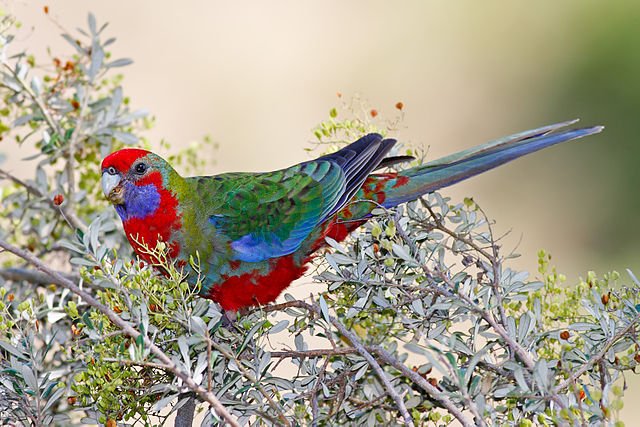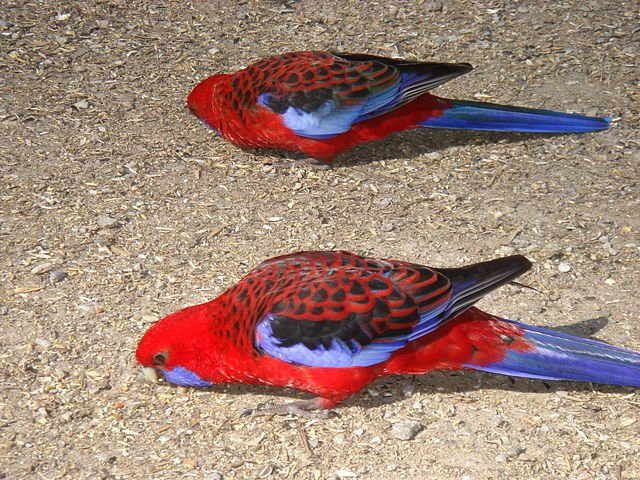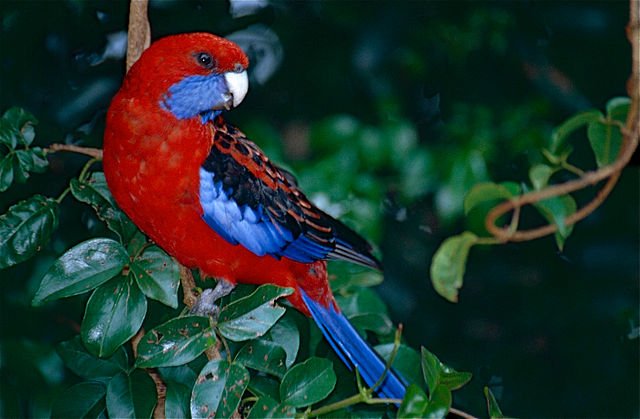Thinking of Crimson Rosellas, the first thing that comes to mind is their vividly-colored plumage. One might think that his beauty is eternal. But as the good-old saying goes: nothing is constant.
The diet keeps his system running but a balanced diet makes that system work at its best. So, what kind of diet would keep these showy parrots at their best?
Crimson Rosella Diet in the Wild
Crimsons in the wild have a platter full of variety. From feeding on the seeds of the various trees and grass to taking in the nectar from the flowers, the options are endless. Varied fruits, flowering buds, and herbs, they love raiding the forests and the orchards alike. But their all-time favorite is the Eucalyptus tree seeds of all varieties.

Additionally, the birds also feed on the insects and their larvae when in the wild to get their daily dose of proteins. Insects like mealworms are their preferred choice.
With the increase in their population, Crimson Rosellas can be easily spotted in the backyards or city parks. They love gorging on the seed mixes kept especially for them by many bird lovers.
Crimson Rosella Diet in Captivity
Pet birds tend to have a longer life in captivity provided they get the right care and a balanced diet. A healthy and balanced diet not only keeps them in good health but also keeps the diseases at bay. But this diet must be adjusted to his various life stages.
Crimson Rosella Baby Diet
As in the wild, a baby Crimson is not capable of self-feeding. Eating his fruits or vegetables from the dish and drinking water is almost impossible for the bird.
Hence the Crimson owner has to hand-rear the bird just like Crimson parents rear them in the wild by feeding the chicks. The baby Crimsons are fed store-bought formula with the help of a syringe or tube especially made for this purpose.
This baby-food has all the nutrients that a juvenile needs to stay healthy and grow naturally. For a single meal, a tablespoon or two of the store-mix is sufficient. And four meals per day are enough to fulfill their daily nutrient requirements.
Adult Crimson Rosella Diet
Seeds
If there is anything that Crimsons truly love in their diet, it is their portion of seeds. They are addicted to seeds. Feed them canary seeds, safflower or sunflower seeds or a healthy mix of them all, they love it. One can also rotate by replacing one or two seeds from the mixture with chia, quinoa or barley, etc., depending on what his individual bird prefers.
A healthier way is to feed the seeds sprouted. The process reduces the fat content, thereby reducing the chances of the bird getting obese by gorging a little extra on them.
Fruits
Crimsons love feeding on fresh fruits when in the wild. This holds true in captivity too. Feed them apples, mango, oranges, blackberries, grapes, strawberries, or blueberries, the options are endless.
One can serve them chopped, diced, or pureed, it all depends on how the bird feels easy and comfortable to eat. The owner needs to find his bird’s preference by trying with different sized portions.

Picture by Bill Ebbesen. CC
Where it is important to serve him healthy fruits, one must know the unhealthier ones too. Fruits that are high in sugar content like grapes must be fed in small quantities only. Also, make sure to keep the feed fresh and discard the stale serving.
Any fruit bowl left uneaten by the bird for more than a few hours must be thrown away as it might have become a breeding ground for bacteria.
Vegetables
Another must-have to make Crimsons platter wholesome is his daily share of greens. Feed them kale, beet greens, lettuce, or watercress. Additionally, the orange and the dark-skinned vegetables fulfill their daily Vitamin A needs. One can serve them small cubes of sweet potatoes, winter squash, or pumpkins. And to make their bones strong and healthy, add broccoli or spinach to maintain their calcium reserves.
Pellets
Pellets are a great way of supplementing Crimson’s diet with all the missing nutrients. They are available in pet stores or online and must be served as 50 percent of the bird’s diet. Choosing a high-quality brand pellet-mix is imperative as they have no harmful additives.
Check out our affiliate store for best seed mixture:
Nuts
When in the wild, Crimsons feed on varieties of nuts and they love them while at home too. They are a great source of EFA that strengthens the brain functioning. Nuts can be either sprinkled on their seed mix or can be given on special occasions as a treat.
The key is to keep their quantity quite low as they are high in fatty acids. Serve them chopped walnuts or almonds to keep their platter rewarding. A half nut a day is sufficient for the bird to keep fat from accumulating.
Cuttlebone
Calcium is essential for Crimsons for healthy and strong bones. And it gets all the more necessary for the female Crimson during the breeding season since all her calcium reserves get quickly used up in egg synthesizing. The best way to provide them their daily dose of calcium is by providing them a cuttlebone to chew upon. It not only is a great calcium supplement but also helps in keeping the bird’s beak in shape.
Freshwater
Apart from keeping hydrated, water regulates all the body functions along with maintaining body temperature, not only in humans but in animals and birds too.
When in the wild, Crimsons choose only those trees as their nesting sites that are close to a water source. In captivity also, their water intake needs must be taken care of very well.
A freshwater bowl must always be present inside his cage. In fact, one must keep a backup water dish in case the first one runs out of supply. Both dishes must be kept filled all the time. Change the water every time before refilling the water bowl. The freshwater must be of drinkable quality, i.e., use either filtered water or boil the water before cooling it down and filling in the bowl.
Other Crimson Rosella food
When in the wild, Crimsons regularly love munching on insects and its larvae. Many owners prefer to make them feel-at-home, i.e., make them feel closest to their habitat and serve them insects every now and then.
But if one does not endorse the idea, he can serve some boiled eggs for the bird’s protein fix. Boiled eggs are another favorite of Crimsons and many jumps at the sight of their boiled egg platter. But moderation must be strictly adhered to while serving boiled eggs to Crimsons as they have a lot of fat content in them.

What Not to Feed to Crimson Rosella
Where there are numerous healthy food options to feed to this beautiful species, one must take care of accidentally feeding something unhealthy or toxic. Anything that contains caffeine or alcohol must be totally off the bird’s feeding list.
Pitted fruits like avocado and sulfur-containing foods like onion must also not be served. Steer clear of all the carbonated drinks and mushrooms and don’t forget to remove seeds from their fruit servings.
There has been debate around serving dairy and the allied products to Crimsons. Many owners feel it safe to feed them to the bird and many others are against the practice citing that parrots are lactose intolerant. But the fact is that they are not 100% lactose intolerant. If given a chance in the wild, they do gorge on milk and its products. The key is the quantity of the product.
If the bird is fed a cottage cheese cube of the size of a carrot-top, it will not be difficult to digest for him. But if the bird is served a bowl full of yogurt, it will be impossible for him to digest and he is bound to fall sick. So keeping them as a treat-kind-of-food would be the best bet.
Summing Up
A right diet choice can lend longevity to Crimsons. They usually have an average life span of 20 years in the wild and are able to live more than 25 years in captivity courtesy a nutritious diet. Each food portion to the bird must always be served carefully as even a single mistake could prove fatal for the bird. In case there is any confusion, one may take the guidance from an expert or vet as wrong feeding might cause health complications in the bird.
Read more about Crimson Rosella Breading:
https://parrotquaker.com/crimson-rosella-breeding-information/



